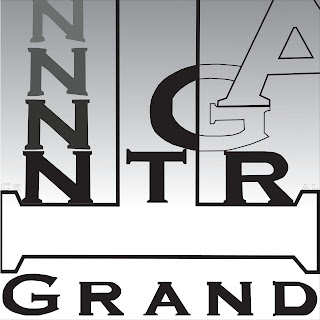

The goal of this design was to emphasize the difference in form of the two fonts despite their similarities. Both are serif fonts that include only capital letters. The University font is a much more elongated, elegant font with curved forms and thin linear elements. On the other hand, the Grand Central font is shorter in stature with thick, broad elements, a blocky form, and wider spacing. I chose to use both pages of this project to reinforce each other. I began by choosing to represent the University font with predominantly white lettering and the Grand font with black lettering so as to emphasize their contrasting thickness. I positioned the primary lettering of the full words in such a way that highlights an animation of their form. For example, I wanted to show the short stature of Grand by having it appear to be pushed down on by the graphics above while University is raised above with more freedom to extend upwards. These two actions are created by the integration of both fonts’ T characters. The difference in these characters is clear: the top T has curvature where the bottom T has sharp, clear angles. In order to continue to bring together the two boards, I established a blend of both fonts’ N characters to show a clear transition. In addition, I used a gradient of grayscale to provide a clear flow from one page to the other as well as to alternate positive and negative tones.
The individual design of the University page is intended mostly to highlight thinness and curvature. The various characters in the background are arranged so that their curved paths align and that their similarly curved serifs conjoin. I chose to gradually reduce the size and stroke of the characters as they appear to go back in the distance of the page so as to reinforce the concept of the thin nature. Another primary feature of this board is the blown up U character that frames the page in order to bring attention to the way this font has a tendency to have a greater width on the left side then transitions to a sleek smaller width on the right.
The individual design of the Grand Central page is intended to highlight thick, bold width as well as block-like features. The added characters to this page are stacked to emphasize the sharp angles. I also chose to animate the actual word usage on this page by centering the word ‘central’. To provide more emphasis on the edges of the font, I again used stacking, this time on top of the larger scale serifs of the T. In contrast with the first page, the stroke and scale of the additional characters increase as they are intended to pop out of page to establish the bold features of the font.




 sdfkjh
sdfkjh




































